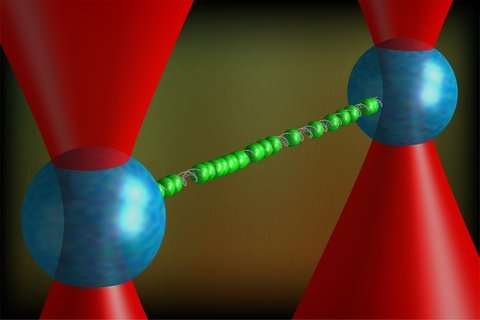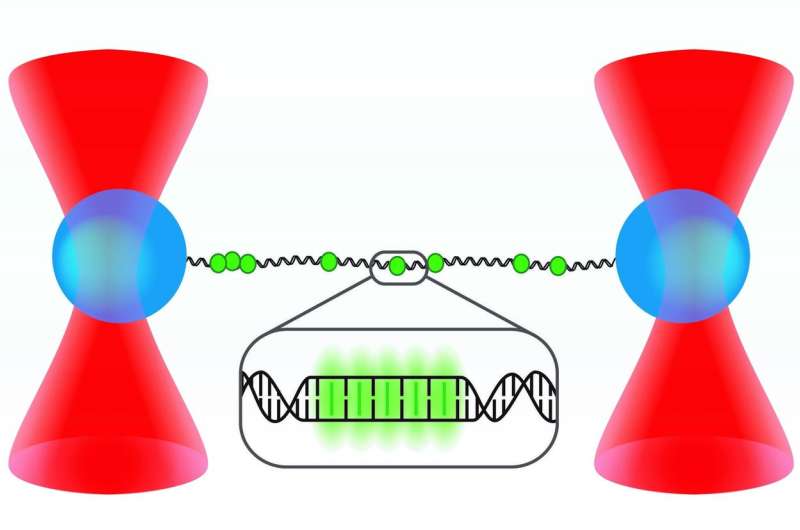New configuration of DNA discovered

Pulling sufficiently hard on DNA may cause it to unfold, doubling its total length. This new state of DNA is announced today by researchers from Eindhoven University of Technology (TU/e) and the Vrije Universiteit Amsterdam (VU). Their theoretical model predicted the existence of this unique state, which they have dubbed 'hyperstretched DNA' for the fact that it is more extended than any form of DNA seen before. An elegant microscopy experiment confirmed this prediction. Their work appears today in the journal Nature Communications.
DNA can be stretched like an elastic band. Inside the nucleus, the long double helices are usually crumpled up. When the genetic information needs to be read, however, those DNA molecules need to be deformed and opened up, to allow access to the individual base pairs. To date, it was thought that DNA could only be extended by a maximum of 1.7 times its normal length. Oddly enough, no-one had investigated how it could, perhaps, be stretched even further.
A theoretical model first brought this possibility to the attention of the TU Eindhoven researchers. As a then-undergraduate student, Koen Schakenraad (who won the Lorentz Prize for best graduation project in theoretical physics and is now pursuing a Ph.D. in Leiden) wanted to describe earlier VU measurements of stretching DNA. "We managed to do that but, to our surprise, our model also predicted another, quite unfamiliar form of DNA, a full two times longer than normal," says Paul van der Schoot, one of the TU/e researchers.
Microscopic hands and eyes
Their VU Amsterdam-based colleagues went looking for this this new state, hoping to confirm it in experiments by using a combination of force- and fluorescence microscopy. "It's like having microscopic hands and eyes," says Iddo Heller, one of the researchers from the VU Amsterdam. "You pull on a single DNA molecule, and you immediately see what is happening." By quite literally lighting up the DNA, they were able to show that the new state actually exists.

The evidence brought to light
"To stretch DNA we use fluorescent molecules called intercalators that connect to the DNA between the base pairs," explains Heller. "These molecules light up under the microscope. So, in the normal state of the DNA without intercalators, the image is dark. The more the DNA stretches, and the more intercalators become attached, the more the image lights up. In the end, a doubling of the light intensity provided the evidence for the new state that we were looking for."
Whether the double length-DNA is actually present in the cell is uncertain. "But the discovery may well be able to provide more clarity on how DNA actually stretches in the cell nucleus—plenty of questions still remain about this," says Van der Schoot. The results may also prove relevant to the relatively new field of "DNA origami," "where researchers 'tinker' with DNA on the basis of its mechanical properties, for example to make new materials," says Heller.
Van der Schoot believes that this discovery once again highlights the importance of fundamental research. "Almost all applied research has a fundamental component. In this case it was the theory that prompted this discovery." Heller speaks of "one of the most enjoyable collaborations between theoretical and experimental physicists. It completes the circle," he says. "It began with an observation, which was followed by a theory. That theory made predictions that we were subsequently able to confirm through an observation."
More information: Koen Schakenraad et al. Hyperstretching DNA, Nature Communications (2017). DOI: 10.1038/s41467-017-02396-1
Journal information: Nature Communications
Provided by Eindhoven University of Technology





















